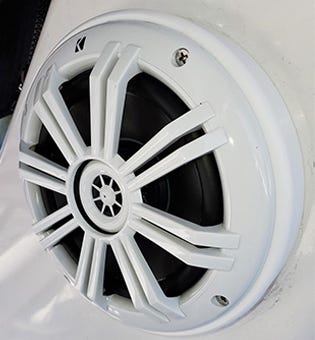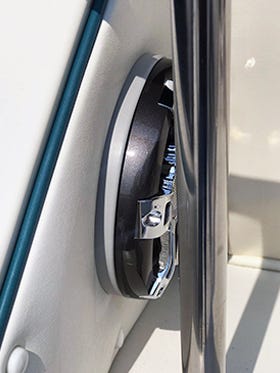

It’s an all-too-common problem for DIY boat owners — removing or replacing an accessory or part leaves unused fastener holes or, worse yet, unneeded or oversized cutouts. Maybe you’re replacing a VHF radio with a new one that requires a smaller cutout. Maybe your new multifunction display is networked to your engines making your old analog gauges obsolete. Or maybe your new speakers are an inch smaller in diameter than the old ones.
Regardless, assuming you’re not skilled in fiberglass or aluminum fabrication, you have three basic choices:
- Take your boat to a fiberglass or aluminum shop to get the old holes or cutouts professionally repaired,
- Make sure they’re waterproofed but otherwise just leave them alone, or
- Cover or hide them with something.
Contents
The Basic Choices
The first choice is great if you have the money and time to invest and know a good shop. But quality fiberglass work isn’t cheap, and good shops are often backlogged. The second choice is usually fine as long as you’re not concerned with aesthetics. Just be sure to seal any exposed coring and fill any holes that might allow water to get places it shouldn’t be, like on the wiring inside your console.
The third choice is often the best, all things considered. Covering holes and cutouts with King Starboard or acrylic trim is considerably less expensive than glass or aluminum fabrication and easily DIY-able, yet it still provides a clean, buttoned-up look.
With Starboard, you can cut and shape your own trim pieces with standard woodworking tools, but many boaters find it’s easier to have pieces cut to their specs.
Boat Outfitters offers precision CNC-cut circles, rectangles and rings in a variety of colors and thicknesses. Here are a few considerations to keep in mind when planning a project.
Shapes and Sizes
Starboard trim pieces can be cut in rectangles or circles, with or without a center cutout. Circles and rectangles with a center cutout are commonly referred to as Trim Rings and Trim Plates, respectively.
Both rectangles and circles are available with routered “roundover” edges in several radius measurements for a finished appearance. Rectangular pieces can also be ordered with radiused outside corners in your choice of radius measurement. Inside corner radius can be specified separately on rectangular trim plates with a center cutout.
Note that both trim rings and trim plates with a center cutout are required to have a width of at least 1/2” on all sides when ordered online.
For example, a 10” x 5” rectangle can have a center cutout no larger than 9” x 4”, which leaves a 1/2” width on all sides. A 10” diameter ring can have a center cutout no larger than 9” in diameter. Narrower rings and plates can be ordered by phone if needed.
Thicknesses and Colors
All trim pieces can be ordered in your choice of 1/4”, 1/2”, 3/4”, or 1” Starboard. Most thicknesses are available in one of 8 different colors. If you’re trying to match your gelcoat or paint, a Starboard sample chain is a smart investment, as the various shades of white and off-white are difficult to accurately represent on a computer monitor or in print.
In larger, unsupported pieces, thicker material offers greater rigidity. Thicker material can also be helpful when installing speakers, lights, or other devices that need extra depth.
For instance, a 1” thick trim ring effectively creates an extra inch of depth for mounting a speaker in a location that might not otherwise be deep enough — like a hardtop or radar arch.
Thicker trim rings can be used to effectively increase mounting depth for equipment in tight locations like hardtops.
Common Applications
Starboard rectangles, circles, trim plates, trim rings can be used in for innumerable things on a boat, but some of the more common applications we see include:
- Mounting speakers, lights, or electronics in oversized cutouts from old equipment
- Adding trim rings around speakers or lights for aesthetic reasons
- Adding trim rings around speakers or lights to create extra mounting depth in shallow locations
- Covering old, unused cutouts for electronics and gauges
- Covering fastener holes from old accessories like bracket-mounted electronics
- Adding extra mounting height or clearance with Starboard shims for equipment like windlasses, winches, swim ladders, and poling platforms
Ordering the Right Size
When ordering a Starboard trim piece for use behind a speaker, head unit, compass, light fixture, or other similar part, many people assume they should order the trim piece to exactly match the footprint of the part — a 10” diameter ring to go behind a 10” diameter speaker, for example.
Ordering your trim piece slightly larger than your part, though, generally yields better results, since it’s very difficult to exactly match the footprint of the part.
A larger trim piece with clean, rounded edges forming a ring around the part will conceal small imperfections and almost always look better than a same-sized trim piece.
For aesthetic reasons, trim plates and rings should be ordered slightly larger than the part being mounted even if additional width isn’t needed to cover an oversized cutout.
Wedge-shaped Trim Pieces
In certain applications, trim pieces that are wedge-shaped can be beneficial. On consoles, for example, a trim plate that is 1” thick at the bottom and 1/4” thick at the top can be used to angle an electronics display several degrees upwards for better visibility.
On transoms that aren’t perpendicular to the centerline of the boat, a wedge-shaped Starboard shim can be used to align transom-mounted transducers with the centerline. Wedge-cut pieces must be ordered by phone.
Stacking Trim Pieces
Boat Outfitters does occasionally make parts from 1-1/2” Starboard, but the material is expensive. Another option if you need more thickness than 1” is to stack two pieces of Starboard.
Some DIYers have installed speakers with stacked trim rings — the “top” one smaller in diameter than the bottom one — to create additional mounting depth and have found this made for a very nice looking install too.
Acrylic Trim Pieces
King Starboard is a nearly perfect material for boat trim pieces — available in a variety of colors; easy to drill and cut; virtually maintenance free; and impervious to sun, salt and water.
In some instances, though, DIYers want a material that can be fastened with glue and/or that has a glossy finish like polished gelcoat. Marine acrylic checks both boxes, and Boat Outfitters does occasionally cut acrylic trim rings and trim plates.
Acrylic is a great material too, but it’s quite a bit more costly than Starboard — roughly two to three times for a typical trim piece — and requires special bits for drilling. Acrylic trim plates and rings offer a high gloss finish to match gelcoat and can be bonded in place without the use of mechanical fasteners. Acrylic trim pieces can be ordered by phone.
The Next Level of Customization
The options available for online ordering through the Boat Outfitters website cover the vast majority of DIY needs, but if you need something more specialized, custom trim pieces can be ordered by phone.
Common customizations include parts made from 1-1/2” Starboard, trim rings and plates narrower than 1/2”, rectangular plates with round cutouts (which are often used to replace traditional audio head units with round digital head units), and rectanglar plates with offset cutouts.







